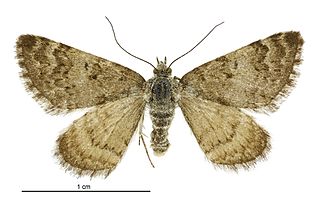Related Research Articles

The Pacific golden plover, or Pacific golden-plover is a medium-sized plover. The genus name is Latin and means relating to rain, from pluvia, "rain". It was believed that golden plovers flocked when rain was imminent. The species name fulva is Latin and refers to a tawny colour.

The red climbing mouse, also known as Vernay's climbing mouse, is a species of rodent in the family Muridae. It is named after explorer and antiques dealer, Arthur Vernay, who sponsored the expedition during which the animal was first discovered. It is the only living species in the genus Vernaya, and has no subspecies.
Focillodes is a genus of moths of the family Erebidae. The genus was erected by George Thomas Bethune-Baker in 1906.
Doratopteryx is a genus of moths in the Himantopteridae family.

Denticucullus pygmina, the small wainscot, is a moth of the family Noctuidae. It is found in most of Europe, ranging from northern Spain, through Portugal as far north as Finland. In the east it is found across the Palearctic to the Russian Far East and western Siberia. It is also found in North Africa, Turkey, the Caucasus region and northern Iran.
Eois fulva is a moth in the family Geometridae. It was described from San Antonio.
Tridrepana fulva is a moth in the family Drepanidae. It was described by George Hampson in 1893. It is found in Tibet in China, Sikkim in India and Nepal.
Doratopteryx camerunica is a moth in the Himantopteridae family. It was described by Hering in 1937. It is found in Cameroon.
Doratopteryx collarti is a moth in the Himantopteridae family. It was described by Hering in 1937. It is found in the Democratic Republic of the Congo.
Doratopteryx filipennis is a moth in the Himantopteridae family. It was described by Hering in 1937. It is found in Tanzania.
Doratopteryx flavomaculata is a moth in the Himantopteridae family. It was described by Hering in 1937. It is found in the Democratic Republic of the Congo.
Doratopteryx laticauda is a moth in the Himantopteridae family. It was described by Hering in 1937. It is found in Tanzania.
Doratopteryx latipennis is a moth in the Himantopteridae family. It was described by Hering in 1937. It is found in the Democratic Republic of the Congo.
Doratopteryx afra is a moth in the Himantopteridae family. It was described by Alois Friedrich Rogenhofer in 1884. It is found in South Africa and Tanzania.
Doratopteryx dissemurus is a moth in the Himantopteridae family. It was described by Sergius G. Kiriakoff in 1963. It is found in Guinea.
Doratopteryx plumigera is a moth in the Himantopteridae family. It was described by Arthur Gardiner Butler in 1888. It is found in South Africa and Tanzania.
Doratopteryx steniptera is a moth in the Himantopteridae family. It was described by George Hampson in 1919. It is found in Tanzania.
Doratopteryx xanthomelas is a moth in the Himantopteridae family. It was described by Walter Rothschild and Karl Jordan in 1903. It is found in Angola.
Doratopteryx zopheropa is a moth in the Himantopteridae family. It was described by George Thomas Bethune-Baker in 1911. It is found in Uganda.

Paranotoreas fulva is a species of moth in the family Geometridae. This species is endemic to New Zealand. It is classified as "At Risk, Relict" by the Department of Conservation.
References
- ↑ Beccaloni, G.; Scoble, M.; Kitching, I.; Simonsen, T.; Robinson, G.; Pitkin, B.; Hine, A.; Lyal, C., eds. (2003). "Doratopteryx fulva". The Global Lepidoptera Names Index . Natural History Museum . Retrieved May 1, 2018.
- ↑ Afro Moths
| This article relating to the superfamily Zygaenoidea is a stub. You can help Wikipedia by expanding it. |